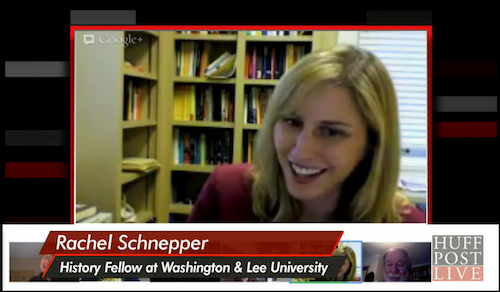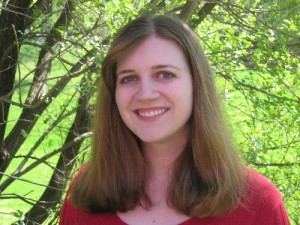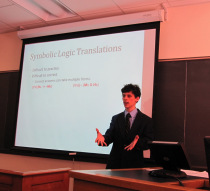See the story on the W&L news blog.
See the story on the W&L news blog.
Professor Curtis Jirsa’s spring term students in ENGL 314, The History of the Book, compiled a detailed exhibit of 3 early printed texts housed in Leyburn’s Special Collections. The URL is: http://www.leyburnarchives.wordpress.com/. You can navigate the site via the menu at the top. Clicking on the name of each book in the menu will bring you to a preliminary page, and then clicking on the submenus will provide more historical and bibliographic information.

For Dr. Rachel Schnepper and her students in History 229: Media and Politics in Early Modern England, studying life and culture in sixteenth and seventeenth century England from Lexington, VA is a difficult task. While there are many secondary sources available at Leyburn Library, the primary sources are lacking. Thanks to online access to many digitized primary sources, however, students can begin to formulate and answer new research questions that previous generations of undergraduate researchers could only dream of.
“Using digital humanities databases greatly expands the primary sources available to students. With these databases, students can access eighteenth century English court records and newspapers, passenger manifests of penal transport ships to Australia, or the records of slavers from the Trans-Atlantic slave trade. Access to all of these would be impossible for my students without the developments that have occurred in digital humanities in the past 10 years.”
Schnepper’s student Elizabeth Bucklee ’13 agrees. Her final paper project examines the libels written in response to the 1631 trial of the earl of Castlehaven whose wife and son accused him of rape and sodomy. Elizabeth studied the libels using Early Stuart Libels, a database of early seventeenth century political poetry. Elizabeth noted that this was the first time she actively searched for primary sources on her own: “Usually for a humanities paper, you figure out your topic, do a book search in Leyburn, logon to JSTOR, and see where that takes you. The context in which I was looking for [primary sources] was completely different and that changed the nature of the search. I looked at the primary sources first and foremost in determining my topic.”
Elizabeth and another student from History 229 presented their final paper projects in the first organized digital humanities panel discussion in the history of W&L at the Science Society and the Arts (SSA) conference held in March. The packed panel session that Schnepper organized and helped lead brought together students and faculty from history, classics, German, and computer science.
Det Beal ‘14 also presented his work from Schnepper’s 218 course at SSA in a busy afternoon poster session. Using the Burney Database, Det traced the usage of the use of the word “yankee” in British newspapers during the American Revolution, which revealed how “as the war progressed and British defeat became more evident, Britains stopped using the word as much and it became almost invisible after the war.”

Based on his experience with digital databases in Professor Schnepper’s class, Det felt empowered to expand the scope of his papers in other classes: he knew he could access similar online resources for other topics that interested him, which he has done this past term in Prof. Senechal’s History of Violence in America course. “Professor Schnepper’s class opened my eyes to the kind of wide ranging research you can do. You are not simply limited to what the professor gives you. Professor Senechal allowed us to either do an incident that she knows that was very well publicized, which a large majority of the class is doing, but I chose instead to pick something of my interest because I knew the [digital] resources would be available to get in-depth with a project that I was really interested in.”
Schnepper reiterates the value of the digital data: “The aggregating of all of this material digitally allows both me and my students to manipulate the primary sources to reveal new insights into the past. For example, my GIS representation of London stationers of the 1640s enables me to physically reconstruct the print trade of revolutionary London along the lines of religious and political allegiances.”
Brendan Hartsell ’13, another student in Schnepper’s History 229, has likewise used online databases to create his own analytical frameworks to uncover and analyze popular perceptions of Quakers during the second half of the seventeenth century. Using the English Broadside Ballad Archive, Hartsell was able to hone his data analysis skills. He said, “I was able to look through all of these broadside ballads and figure out where they fit in a number of criteria. Through this, I was able to find a lot of information that had not previously been published, like the prevalence of sexual themes.” He added, proudly, “In the past, any data would have been received from secondary sources, so this is my first time actually finding that out for myself.”
Brendan’s pride underscores one of Schnepper’s main pedagagical goals: in using the digital humanities resources, students become skilled in a variety of analytical tools. “Students learn how to navigate new technologies with savvy, how to manipulate digital resources and massage information out of them. These are invaluable skills for them to learn, particularly in a world that has taken a digital turn,” she said. Thus, advocacy is the central role Schnepper has played during her second year as a Mellon Post-doctoral Fellow in history.
Beyond her own courses, Schnepper has been an active consultant for the new W&L Introduction to Digital Humanities Spring term course. “Dr. Schnepper has been a great resource of ideas on what topics and tools we should cover and how we can engage the broad, multi-disciplinary student audience,” said Dr. Sara Sprenkle, assistant professor of computer science, who is co-teaching the new course with Dr. Paul Youngman, associate professor of German. Youngman also emphasizes her value as a sounding board, “Professor Schnepper’s rich imagination has proven to be a real asset as we begin planning for this unique course.”
Schnepper has been a resource to other faculty as well. She said, “With my colleagues here at W&L, I’ve found that many are very interested in the digital humanities and have projects of their own in mind, only they simply did not know how to go about doing them.” She has been involved in conversations with professors in departments across campus, learning about their research and sharing with them the digital tools available to realize their ideas. Associate professor of sociology Jonathan Eastwood is one of those faculty members who sought Schnepper’s counsel. He said, “Rachel has been a great resource as I have begun taking an interest in digital humanities initiatives. Not only is she knowledgeable about a wide range of tools, but she is also a trained historian. As such, she is uniquely capable of drawing linkages between technological resources and the kinds of substantive questions in which I am interested.”
Schnepper is optimistic about the future of history and the digital humanities. She said, “Digitizing the archive will enable historians to not only do the sort of archival research they love to do, but allow them to do it in new and immensely productive ways that reveal more about the past.” Beyond historians themselves, Schnepper is excited by the opportunities to “make the digital archive a useful and productive resource not just for us historians, but also for the students in our classrooms and the students outside of universities who want to learn more about their history or the history of other countries.”
Over five years ago, Professor Paul Gregory from the Philosophy Department came to the Computer Science Department with a problem.  He needed a computer application that not only would help students practice symbolic logic for his Philosophy 170: Introduction toLogic course, but could also assist him in his grading by automatically correcting symbolic logic quizzes. In agreeing to collaborate with Gregory, little did Professor Sara Sprenkle realize that she was going to become to go-to computer science person for humanities professors across W&L. For, since then, Sprenkle’s partnership has been sought on a number of other digital humanities projects for faculty throughout the university.
He needed a computer application that not only would help students practice symbolic logic for his Philosophy 170: Introduction toLogic course, but could also assist him in his grading by automatically correcting symbolic logic quizzes. In agreeing to collaborate with Gregory, little did Professor Sara Sprenkle realize that she was going to become to go-to computer science person for humanities professors across W&L. For, since then, Sprenkle’s partnership has been sought on a number of other digital humanities projects for faculty throughout the university.
At present, Sprenkle is working on two digital humanities projects in addition to Gregory’s symbolic logic tutorial. The first is with former Mellon Postdoctoral fellow and current Assistant Professor at Marquette University Professor Sarah Bond to develop a site that would allows users to examine the evidence and literature for ancient voluntary associations. The second and most recent project with Professor Rebecca Benefiel of the Classics Department seeks to explore the relationships of graffiti in ancient Herculaneum. Benefiel and Bond projects are similar in that both wanted to be able to search large collections of ancient inscriptions in order to look at them in different ways, allowing them uncover new things about the ancient world.
While at first glance, it may appear as though these collaborations benefit only Gregory’s logic classes or Benefiel and Bond’s research, this is hardly the case. Indeed, these digital humanities collaborations have proven to be tremendously important for Sprenkle’s own research on web applications. “My research looks at what can we learn from what users actually do,” Sprenkle explained. “I do software testing research specifically on web applications. We need real applications and have people really using them. I can use these applications in my research to learn how to do better testing for these applications.”
This is precisely what these projects with Gregory, Benefiel, and Bond have provided. For example, Gregory’s symbolic logic tutorial is one of the five web applications Sprenkle and her research collaborators at the University of Delaware look at. “The logic application is great,” Sprenkle described, “because we have actual users.” In fact, over the last two semesters, it had over 800 user sessions. Sprenkle and her research collaborators have published three papers evaluating testing techniques using the symbolic logic tutorial, a clear indication of the value of this project to Sprenkle’s research.
But it is not just Sprenkle’s research that benefits from digital humanities collaborations here at W&L. They are also amazing opportunities for students here as well. In fact, this was something that Sprenkle recognized immediately. “I thought it would be a great application for our students to work on,” Sprenkle said.

Richard Marmorstein ’14, a double major in Computer Science and Economics, agrees. Since the summer of 2012, Marmorstein has been working with both Gregory and Sprenkle on the symbolic logical tutorial. “Usually you’re working on code that your professors have coded for you and modifying it or rewriting code from scratch,” Marmorstein said. “But this was code that other people had written that weren’t professors so it was a little messy going in to it, which is like real life. The people that you work with aren’t always perfect in writing code so it was a real, practical experience.”
This real, practical experience is already paying off for students. Because they are working with an actual client, i.e. Gregory, Benefiel, or Bond, students working under Sprenkle’s supervision on her three digital humanities projects, either as part of her web applications course or as independent studies, are more attractive to potential employers. Her students have reported how “recruiters eyes light up when they start talking about these projects because personal interactions are really important to employers.”
“Students learn a lot from these projects,” Sprenkle added. “And when they talk to their client later, they not only think they were cool projects, but also fun and worthwhile.”